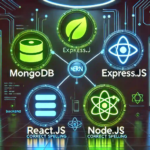Web development has evolved significantly over the past decade, and the need for efficient, scalable, and full-featured applications has led to the rise of robust technology stacks. One of the most popular and powerful combinations today is the MERN stack. Comprising MongoDB, Express.js, React, and Node.js, the MERN stack allows developers to use JavaScript end-to-end, making it a go-to choice for building full-stack applications.
Whether you’re aiming to build a blog, a social media platform, or an e-commerce site, learning the MERN stack equips you with all the necessary tools to develop responsive, high-performance applications. This guide will walk you through each component, how they integrate, and how you can get started from scratch.
What is Full-Stack Development?
Full-stack development refers to the creation of both the frontend (client side) and the backend (server side) of a web application. Traditionally, these components were developed using different languages—JavaScript for the frontend, PHP or Python for the backend, and SQL for the database. However, with the advent of full JavaScript stacks like MERN, developers can streamline the entire process using a single language.
Using JavaScript throughout the application simplifies collaboration between frontend and backend teams and allows individual developers to build entire applications without switching contexts between languages.
Understanding the Components of the MERN Stack
MongoDB: The NoSQL Database
MongoDB is a document-based NoSQL database that stores data in a flexible, JSON-like format. Unlike traditional relational databases, MongoDB does not require a predefined schema, making it ideal for modern applications that handle varied and evolving data structures. It is also highly scalable and supports fast querying.
Express.js: Lightweight Backend Framework
Express.js is a web application framework built on top of Node.js. It simplifies the process of building server-side logic and APIs. With Express, developers can manage routes, handle HTTP requests, implement middleware, and manage error handling with minimal setup.
React: Declarative Frontend Library
React is a JavaScript library developed by Facebook for building user interfaces. It uses a component-based architecture, which promotes reusability and maintainability. React’s virtual DOM makes UI updates efficient and seamless, making it suitable for building dynamic, high-performance frontend applications.
Node.js: JavaScript Runtime Environment
Node.js enables JavaScript to run on the server side. It uses a non-blocking, event-driven architecture that allows for building scalable network applications. With Node.js, developers can handle multiple requests simultaneously, which enhances performance and responsiveness.
Advantages of Using the MERN Stack
- Unified Language: JavaScript is used across all components.
- Open Source: Each part of the stack is open-source, backed by strong communities.
- Scalability: Designed to handle complex, large-scale applications.
- Performance: Event-driven architecture and asynchronous processing improve speed.
- Developer Efficiency: Easier learning curve due to single-language development.
Setting Up the MERN Stack
To begin working with the MERN stack, you need to set up your environment:
- Install Node.js and npm – These are required for running your server and installing packages.
- Install MongoDB – You can run it locally or use a cloud-based solution like MongoDB Atlas.
- Set Up a Code Editor – Visual Studio Code is highly recommended for its extensions and features.
- Version Control – Use Git and GitHub for collaboration and version tracking.
Once your environment is ready, create a backend directory and initialize a Node.js project using npm init. Install essential packages like express, mongoose, and cors.
Creating a Simple MERN Application
Backend Setup
- Use Express to set up routes.
- Connect MongoDB using Mongoose, an ODM (Object Data Modeling) library.
- Create models to define your data schema.
- Set up API routes to handle CRUD operations.
Frontend Setup
- Use Create React App (CRA) to bootstrap your frontend.
- Build reusable components (e.g., Navbar, Form, PostList).
- Fetch backend data using Axios or Fetch API.
- Use React hooks like
useStateanduseEffectto manage state and lifecycle.
Connecting Frontend to Backend
Configure a proxy in your React app’s package.json file to direct API calls to your Express server. For example:
"proxy": "http://localhost:5000"This enables seamless integration and communication between the frontend and backend during development.
Adding Authentication with JWT
Security is vital in any application. Use JSON Web Tokens (JWT) to implement user authentication. On user login, the server generates a token and sends it to the client. The client stores this token (usually in localStorage) and includes it in future requests for protected routes.
Deployment Strategies
When your MERN app is ready for production:
- Frontend: Use Vercel or Netlify to host your React application.
- Backend: Deploy your Express server to platforms like Heroku or Render.
- Database: Host your MongoDB instance on MongoDB Atlas.
- Make sure to configure environment variables and build scripts properly.
Common Challenges and Their Solutions
- CORS Issues: Use the
corspackage in Express to configure cross-origin settings. - Database Connection Errors: Ensure correct MongoDB URI and handle errors using try/catch blocks.
- Unoptimized State Management: Use tools like Redux or Context API for large applications to maintain better control over the state.
Best Practices for Learning MERN
- Start with small projects like to-do apps or blogs.
- Gradually build more complex applications with user roles and authentication.
- Read official documentation regularly.
- Engage with online communities on platforms like Stack Overflow, Reddit, or Discord.
Final Thoughts
The MERN stack is a powerful, efficient, and modern solution for full-stack web development. It offers everything a developer needs to build robust, scalable, and maintainable applications. Whether you are a beginner or transitioning from another tech stack, MERN opens up a world of possibilities in the realm of modern web development.
By mastering each component and understanding how they work together, you’ll be well-equipped to tackle real-world projects and advance your career as a full-stack developer.




